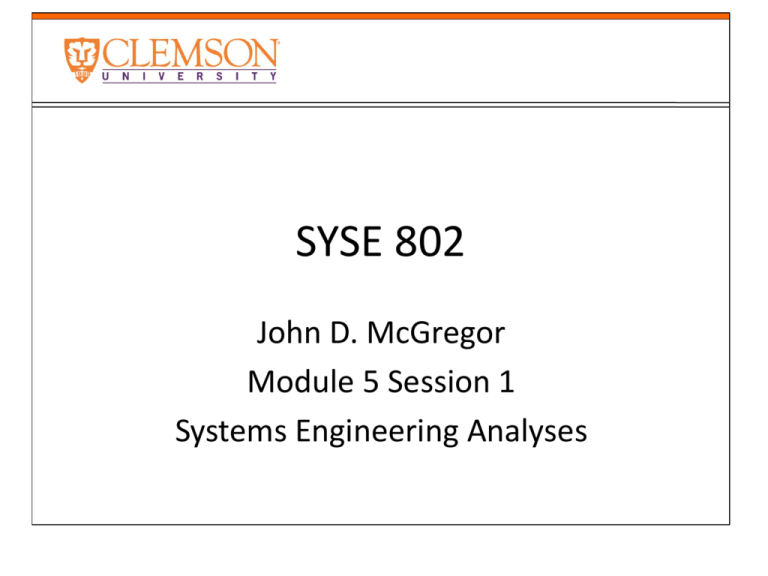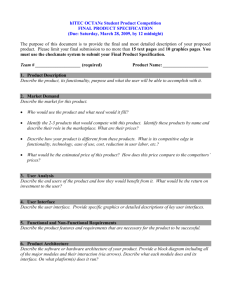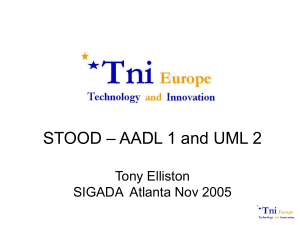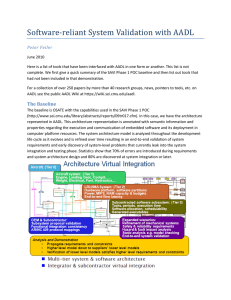SYSE 802
advertisement

SYSE 802 John D. McGregor Module 5 Session 1 Systems Engineering Analyses Session Objective • To provide an introduction to some of the analysis techniques used by systems engineers. SE Analyses • There is a vast number of analyses that a system engineer may conduct or participate in or oversee. The INCOSE handbook has a number listed in chapter 4. • In this module we will consider a few analyses with the idea of understanding each but also considering the more general notion of using the analyses to support decisions. Modularity • Modularity is a desirable quality in both hardware and software design • One decomposition technique is find existing products that satisfy particular requirements. The module size is the size of that product. • Another technique is to start at the bottom with all of the behaviors required in a system and collect them into modules Coupling and cohesion • When one function invokes another that creates a dependency or coupling. • When one module uses another that creates a dependency that couples the two modules. • A good design groups functions that invoke each other with the same module. A module with functions invoking each other is cohesive. • It is not totally possible obviously to have no dependencies among modules but the fewer the better. Design Structure Matrix • The Design Structure Matrix supports several structural analyses of dependencies and particularly an analysis of the module structure. • It can be used to examine the dependencies among hardware elements, software modules or a combination • We use it to consider the boundaries between modules given dependencies (such as function calls). Setting module boundaries so that invocations are encapsulated within modules reduces the complexity of a design. DSM tool • Walk through this tutorial in detail – http://129.187.108.94/dsmweb/en/understand-dsm/technical-dsm-tutorial.html • These references are in case you want more information – Overview, tutorials, etc • http://www.dsmweb.org/ – A multi-purpose tool • http://www-edc.eng.cam.ac.uk/cam/ – Documentation for using CAM as a DSM tool • http://wwwedc.eng.cam.ac.uk/cam/documentation/DSM%20toolbox%20docu mentation%20home Example • We can use the old and new designs for a radio platform from the reference below to see DSMs in action. • Each mark in the matrix indicates a dependency of the vertical axis element on the horizontal axis element. • The tutorials referenced on the previous page will explain the details of the analysis technique. • The light colored squares along the diagonal represent modules collected to absorb as many interactions as possible. • http://www.microtune.com/pdf/Whitepapers/Microtune_Software_Defined_Radio_The_Ne xt-Generation_Automotive_Radio_Platform.pdf Original design New design The multipurpose DSP aggregates former modules Second Example Matrix • Consider the following dependency matrix. One clustering algorithm This clustering begins to group but not sufficiently. Manual Clustered Matrix Two modules account for all the dependencies except for two: d<->e With ‘e’ in one module and ‘d’ in the other, these could be parameters that communicate data between the two modules. A modular design. DSM • There are many different DSM algorithms that have different assumptions and purposes • Instead of just a binary value to represent the whether there is a module or not, numeric values can be used to represent the strength of the dependency. • For example, the value might be the integer count of unique functions that call into a module or the number of items attached to a bus. Trade Studies • Section 4.5.16 in the INCOSE Handbook • A trade study builds an objective case for the selection of one course of action over a set of alternatives. • “Trades” can be analyzed either on a very formal level with publicized criteria and formal means of appeal or an informal level where data is collected and used but no formal report is issued or just back of the envelop. Trade Studies - 2 • A trade study needs a clearly defined set of alternatives from which to select and criteria for evaluating each alternative. • Each alternative should be sufficiently well specified to allow the measures to be applied. • Each criterion should be an objective measure if at all possible although a criterion may be rated by expert judgment. Example • There are three software packages that will satisfy the requirements for one specific module in our architecture. • We have 4 criteria that are important to the success of the project Criteria Measures Quality Test results Security Password-protected; encrypted data Cost Total cost of ownership Complexity of use Number of inputs The table A B C Quality Security Cost Complexity Score – highest wins Scale from 1=poor to 5 = excellent We have to be certain that we are comparing comparable data. If one product Costs per unit and another is a lump sum license, these figures must be reconciled Using anticipated sales to convert the lump sum to a per unit cost. This approach allows for relative ranking rather than determining an exact value for each alternative. The table - 2 Criteria Weight Quality 3 Security 2 Cost 4 Complexity 1 A B C Score – highest wins • Weighting gives a way of emphasizing a criterion that is particularly important. Or you can just have a linear scale. Rank the most important with the largest value. Then multiplying a rank by a weight gives a weighted score in which largest wins. System Modeling • A model is an abstraction of some entity. It is simpler, hopefully easier to understand, but retaining sufficient fidelity to represent needed information. • We have taken a model-based approach from the start of the semester. Our models so far have addressed the requirements and the architecture. • The type of model selected depends upon the system to be modeled and the results desired from the model. Types of models - Physical • Schematic of the mock circulatory system. Arrows indicate flow direction. 1. Atrial head tank with tricuspid valve. 2. Right ventricular chamber. 3. Flow meter. 4. Test chamber. 5. Mechanical heart valve. 6. Resistance elements. 7. Compliance chambers. 8. Reservoir. 9. Pump. 10. Pressurizing flow valve. 11. Venting flow valve. 12. Resistance head tank. Types of models - Graphical • AADL graphical syntax Types of Models - Numerical • Simulink model involving multiple views. Analyses • Different types of models support different types of analyses. • The information extracted from a model must be calibrated to the real system. That is, the output from a model is often on a different scale from the real world. • The intent is to have the model react proportionately to an input as the real system would. Simulation extracts information This is a simulator for AADL. It requires a totally bound system. It creates a static schedule of thread activity and generates a sequence of events to walk through the state space. The latencies are scaled to the real world. Simulation • Ocarina, a set of plug-ins for Eclipse converts AADL code into timed petri nets. • Existing petri net simulators execute the net by firing tokens and traversing all places in the net. • These executions determine whether the system defined by the AADL code could achieve live lock or dead lock. www.sei.cmu.edu Life Cycle Costs • This analysis begins during the early part of the Concept phase and is continually updated until the retirement of the product. • In fact, the information developed in this analysis is a major determinant of whether to launch a product development effort and also in determining when retirement is appropriate. • Section 4.5.6 of the Incose Handbook contains some relevant information. Life Cycle Costs - 2 The Incose handbook offers this breakdown of costs that can be used to determine who should compute which of the costs and when they will be most accurate. Life Cycle Costs - 3 • The costs include the total cost of ownership from analysis and design of the product to maintenance and refreshes. • As the product progresses through its life cycle the estimates of costs are replaced by actual costs and the Life Cycle Cost becomes a more accurate estimate of the final total. • There are many models for life cycle costs. Next we will look at a specific one. Software Product Line model • See Module 5 Session 2 for info about Product Lines before reading this section. • A software product line involves the development of multiple products by a single organization. • Their development is coordinated and costs are reduced because of strategic reuse of assets among the development teams. “Computing Return on Investment for Software Product Lines”; Guenter Boeckle, Paul Clements, John D. McGregor, Dirk Muthig, and Klaus Schmid, IEEE Software, July/August 2004. Product Line costs • We have developed a model of product line costs. The costs are classified as: 1. Corg returns the cost to an organization of adopting the product line approach for its products. 2. Ccab returns the development cost to develop a core asset base suited to satisfy a particular scope. 3. Cunique returns the development cost to develop unique software that itself is not based on a product line platform. 4. Creuse returns the development cost to reuse core assets in a core asset base. n Corg (t ) Ccab (t ) (Cunique( producti , t ) Creuse ( producti , t )) i 1 Product Line costs - 2 • Rather than provide rigorous, in-depth functions to compute costs, SIMPLE is intended to be used for back-of-the-envelope calculations. • The “t” parameter to each term stands for the time when the product is produced. Costs vary with time (maybe extra staff must be hired at peak times). • The “product” parameter is the specification of the product. Obviously the more features a product has the greater the cost to build it. • Note that the first two costs are fixed costs while the next two vary with the number of products in the product line. Structured Intuitive Model of Product Line Economics (SIMPLE) • SIMPLE is intended to support “thought experiments” where the engineers consider many alternatives and do approximate calculations to compare alternatives. n Corg (t ) Ccab (t ) (Cunique( producti , t ) Creuse ( producti , t )) i 1 Uncertainty • Costs estimates are always that – estimates. There is uncertainty about their accuracy. • Three approaches to this problem: – Break down the estimates to cover a smaller piece – Sensitivity analysis – Randomized simulation Uncertainty – Break down • The Software Engineering Institute’s Product Line Practice Framework identifies 29 practices used in product line engineering. • Instead of 4 cost functions we could use 29 • The assumption being that an expert’s estimate at this level is more accurate and in fact we can use experts in each practice. • This results in the spreadsheet found on the next slide. SIMPLE spreadsheet • Columns E – H correspond to the 4 SIMPLE functions. SIMPLE spreadsheet - 2 • Columns E – H give cost estimates per practice. • An “X” in a cell indicates there are no costs for that practice in the SIMPLE term represented by the column. • The three groupings of Software Engineering, Technical Management, and Organizational Management are the SEI’s division. Uncertainty - Sensitivity • Sensitivity analysis refers to whether an X% change in one or more inputs results in a greater change in some portions of the model than others. • For example, the SIMPLE formula is more sensitive to changes in Cunique than Corg since a change in Cunique applies to every product while a change in Corg is only added in once. • One approach to sensitivity is to examine the formula to compute the value being analyzed and look for terms that are more affected by change than others. Uncertainty - Simulation • Simulation allows us to quickly consider a large number of scenarios by varying the various inputs to the computation and computing results. • In the spreadsheet for SIMPLE columns J – M contain values used to form a symmetrical upper and lower bound on the estimated value. • For example, in Row 21 of the SIMPLE spreadsheet, Architecture Definition is estimated to contribute .5 person-years to the cost of the core asset base and the error bound is ±.02 person years. Uncertainty – Simulation - 2 • In this situation a Monte-Carlo simulation is often used. • We use the estimates of cost for each practice as the uncertain values. We assume a normal distribution for each uncertainty. • We use a plug-in to Excel and define the algorithm to sum all the costs after adding a randomly generated addition within the specified bound (.5±.02). • A frequency distribution is created and the results looks like the next slide. Uncertainty – Simulation - 3 • The values in columns J-M are used to modify the values of the practice costs. • A run of 25,000 trials gives fair confidence in the mean value of the results as a reasonable estimate. Summary • We have just scratched the surface on the types of analyses that may be used at the systems engineer level of product development. • In some cases the SE will need to bring in specialty engineers. The physical model of the circulatory system required a bioengineer.






